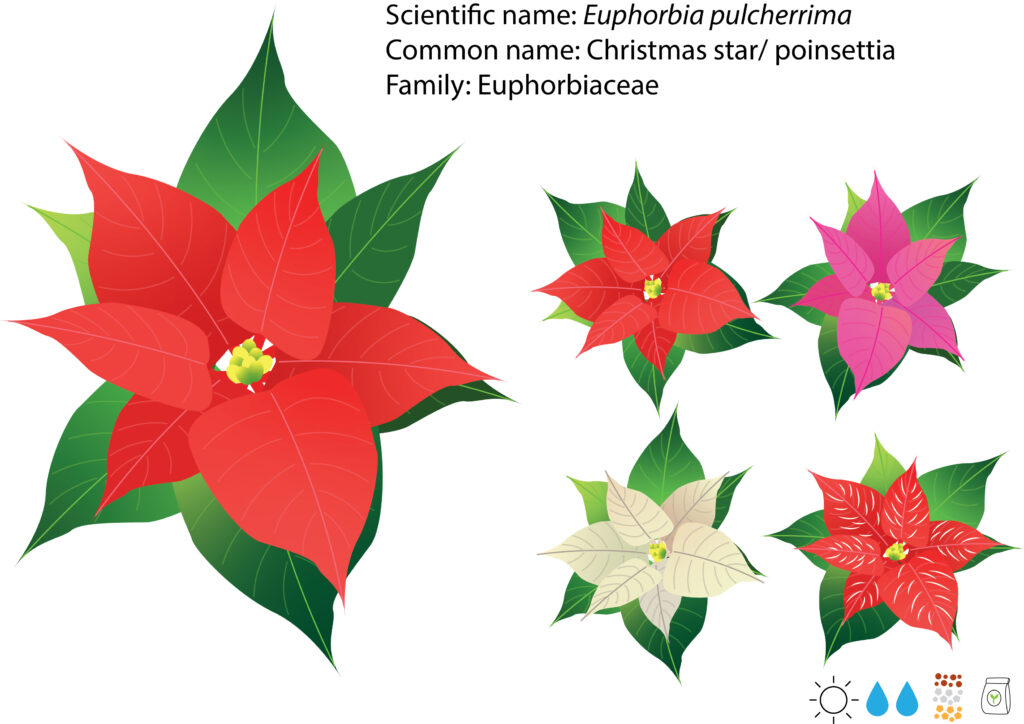Many flower blossoms remind us of radiant stars in appearance and color. The flowers and other plant parts with stars ultimately lead to the Christmas star or star of Bethlehem, which is a natural conclusion from the Christian point of view that dominated even science until at least the end of the nineteenth century. Potted poinsettias are a familiar Christmas decoration all over the northern hemisphere, but this native of Mexico is only a garden plant in frost-free climates. It is believed that the culture of having poinsettia for Christmas comes from Central America and then this plant is widely cultivated and spread to South America in 1828. Its wild form can be seen in the tropical rain forest of the Mexican state of Chiapas, especially near the splendid Mayan ruins of Palenque. In Spanish, it is known as Pascua, Santa, and Santa Catarina, meaning the Christmas star.
It is scientifically known as Euphorbia pulcherrima found under the family of Euphorbiaceae. It is a latex-producing plant. It makes a rather open shrub up to twelve feet tall, usually dropping its leaves as flowering commences. The jagged leaves form a starlike pattern. The leaves are large but not especially attractive. The inconspicuous flowers, which can be found in the middle of the bright red sepals (leaflike structures) that attract the eye, are very small and unattractive. The broad bracts, which give each flower cluster the appearance of a single, huge flower, last many weeks, which made it a perfect cut flower. The tall poinsettia that has red sepals catch the attention the most as they shine like a floral illusion on the stem. Furthermore, the flower blossom miracle is an obvious sign that the time of the holy feast is upon us.
During the Christmas season, potted poinsettias are everywhere in supermarkets and flower shops, which are purchased to decorate the shop windows, public buildings, and private homes. However, why is a poinsettia as a plant from the tropics become such a popular symbol for Advent? This is because it is a plant from the New World, not from the cold winter woods of the north, where the Yule feast originated, or the arid deserts of the Middle East, where the stable of Bethlehem stood. Besides, Mexican folk nomenclature and usage of the plant harks back to old gods and saints and the long-standing role of the plant in Christmas rituals. Moreover, many Indians in Chiapas use the chili pepper-red leaf stars as offerings and dedication gifts for ancient pagan gods or pre-Catholic saints. Furthermore, the Tonotaken, people from the land of vanilla (Central Ameria) who were suppressed by the Aztecs, decorate their altars for Christmas with red and green leaves. Traditionally, it is used by the people in the sixteenth-century to stimulate milk production in nursing women.
There are many named cultivars, which extend the color range from the original blood red to pink and cream. The red poinsettia is flavored in Christmas as the color of red and green are radiant with traditional Christmas colors. Cultivars of the normal tall-growing poinsettia include ‘Henrietta Ecke’ with additional smaller red bracts. Most cultivars now sold for indoor use are semi-dwarf like ‘Annette Hegg’ is red, whereas ‘Rosea’ (pink) and ‘Lemon Drop’ (pale yellow) are similar except for color. It thrives best in subtropical regions and likes fertile soil and sunshine. It does not like a lot of water and a little watering is sufficient when the soil is noticeably dry. It needs to be kept in an area like living rooms with warmth between fifteen and twenty-two degrees Celsius and sufficient light. Interestingly, it can be used as a natural pH indicator as it contains anthocyanins in the red leaves.

Further reading:
Rätsch. C. & Műller-Ebeling. C. (2009). Pagan Christmas – The plant, spirits, and rituals at the origins of Yuletide. Rochester, Vermont.